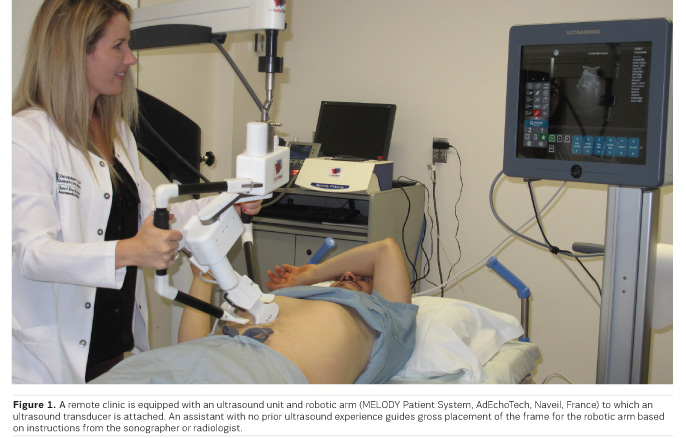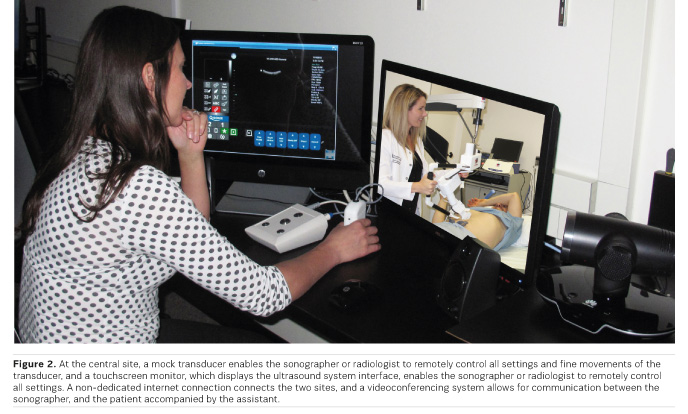HealthManagement, Volume 17 - Issue 1, 2017
What is the current situation for Canadians living in remote communities who need an ultrasound scan? Are there any mobile services, or are they expected to travel?
Approximately 20% of the Canadian population live in rural and remote communities with limited access to imaging due to lack of radiologists, technologists and infrastructure in these communities. Sonography is unique in that it is an operator- and user-dependent imaging modality and the skill and experience of the operator is paramount to accurate diagnosis. Since a sonographer is required to be on-site, ultrasound imaging is simply not available in many hospitals and communities in Canada, and patients—both inpatients and outpatients—must travel or be transferred to secondary or tertiary care centres or imaging clinics. In some cases, this delays diagnosis and subsequent treatment, burdens patients and their families, and increases healthcare costs.
What is the potential for telerobotic Sonography technique based on your initial experiences and current clinical trial?
Our group has trialled a telerobotic ultrasound system for abdominal and second-trimester prenatal imaging, directly comparing telerobotic examinations and conventional examinations.
Using a telerobotic ultrasound system, sonographers could remotely control all fine movements of the ultrasound transducer—including rotating, rocking and tilting—by manipulating a mock transducer at a central site. Sonographers communicated with the patient and an assistant at the patient’s site through a videoconferencing system, and the assistant grossly positioned the frame for the robotic arm based on instructions from the sonographer. We found that organs could be reliably visualised using the telerobotic ultrasound system and measurements of common structures were comparable using the two systems (taking into account the user-dependency of sonography). Importantly, all patients agreed that they would be willing to have a telerobotic scan in the future if conventional sonography was not available in their community.
Telerobotic sonography opens up the possibility of establishing remote ultrasound clinics within smaller communities, enabling patients to access sonography in their home community and improving access to care. Telerobotic sonography may facilitate routine imaging studies or after-hours sonography for emergent cases, possibly avoiding transport to a larger centre for imaging or calling in a sonographer for a single study. In small to medium-sized centres, telerobotic sonography also may enable patients to access subspecialty imaging consultations that would otherwise not be available.
How did previous
studies on telerobotic Sonography inform the set up of your current clinical
trial?
Telerobotic technology has advanced significantly since previous reports; for example, early telerobotic ultrasound systems did not allow users to remotely control settings such as gain or depth, and other telerobotic ultrasound systems required operators to use a computer mouse for movement of the transducer rather than a transducer similar in appearance to that used conventionally. We are now at the point where commercial-grade telerobotic ultrasound systems have been developed, and a key prerequisite for widespread adoption into clinical use is assessment of diagnostic capability. Directly comparing telerobotic and conventional sonography— with sonographers and radiologists blinded to findings of the corresponding examination—is a key part of our assessment.

The initial experiences showed some differences in diagnostic performance between telerobotic vs conventional ultrasound, which could not be attributed solely to the method - how has this been factored in to the current clinical trial? Please comment on the important differences between conventional sonography and robotic telesonography.
In our initial study, there was no significant difference between telerobotic and conventional measurements of liver span and diameters of the proximal aorta and spleen; however, telerobotic assessments overestimated distal aorta and common bile duct diameters and underestimated kidney lengths compared with the conventional scan. Some of the differences in measurements may be related to different sonographers performing the conventional and telerobotic scans (sonography is a user-dependent modality, and variations in measurements may occur between two sonographers using the same ultrasound system with the same patient). Additionally, this may be related to the challenge of positioning the transducer for an optimal view for measurement, which can be more challenging using a telerobotic system, especially for users with less experience in using the system. This has resulted in increased duration of examinations, though we have found the duration of exams continues to decrease as sonographers gain additional experience using the system.
You envisage a network of telerobotic ultrasound systems in remote centres to be serviced by sonographers at central telerobotic sonography clinics. What would the business case be, compared to providing mobile services, for example?
Many centres do not have sufficient patient volume to economically justify employing sonographers in their communities, and even in communities with sufficient volume, recruitment and retention of sonographers remains a challenge. Mobile services provide only sporadic coverage and may not be available for acute or semi-urgent imaging. For prenatal imaging, many patients simply forego imaging due to the lack of availability of sonography in their home community, compromising patient safety and potentially resulting in higher downstream healthcare costs.
We believe networks of telerobotic ultrasound systems in rural, remote or low-volume centres—established in partnership with local communities and healthcare organisations—will fill an unmet need in providing timely access to ultrasound services. Sonographers at a central site would remotely perform routinely scheduled examinations, with urgent and emergent cases from any community added as required.
Images from telerobotic examinations can be transferred into existing PACS so that remote examinations become integrated into the daily workflow for radiologists. In North America, in a mainly fee-for-service environment, adoption of telerobotic sonography can increase volume and revenue for radiology groups that report remote studies. Telerobotic sonography may be a natural extension for teleradiology providers in terms of both image interpretation services as well as the technical component of performing telerobotic examinations.
Barriers for widespread adoption include capital costs of equipment (the cost of a complete telerobotic ultrasound system is approximately equivalent to that of a high-end conventional ultrasound unit) and the need for development of partnerships with diverse local communities and health organisations.

Ultimately, remote presence technologies such as telerobotic sonography will help to narrow the gap on inequality of healthcare delivery in both industrialised and developing countries. We believe that these technologies will be important in the delivery of healthcare in a timely and cost-effective manner in the future.
There are competing telerobotic ultrasound systems available. Are you able to comment on what the key requirements are for these?
While we don’t want to comment on specific equipment as our work so far has been limited to one telerobotic ultrasound system, in general, off-the-shelf comprehensive solutions integrating robotic, ultrasound and videoconferencing components into single user-friendly systems are required for routine adoption of this technology. High image quality—yet with low bandwidth requirements— is a prerequisite for any telerobotic ultrasound system. An experience as similar to conventional scanning as can be—through use of a mock ultrasound transducer similar in appearance to an actual transducer and ability to remotely control all ultrasound settings as on conventional ultrasound units—will minimise the learning curve for sonographers. Enhanced ability to control movement of the transducer in all planes, with feedback for the sonographer on pressure applied, are key considerations for next-generation systems.
Key Points
- Telerobotic ultrasound systems enable radiologists and
sonographers to remotely control all fine movements of an ultrasound
transducer— including rotating, rocking and tilting—by manipulating a mock
transducer at a central site.
- Networks of telerobotic ultrasound systems in rural,
remote, or low-volume centres—established in partnership with local communities
and healthcare organizations—may enable patients to access sonography in their
home community and may fill an unmet need in providing timely access to
ultrasound services.
- Telerobotic sonography may facilitate routine imaging
studies, subspecialty imaging consultations, or after-hours sonography for
emergent cases, possibly avoiding transport to a larger centre for imaging or
calling in a sonographer for a single study.





